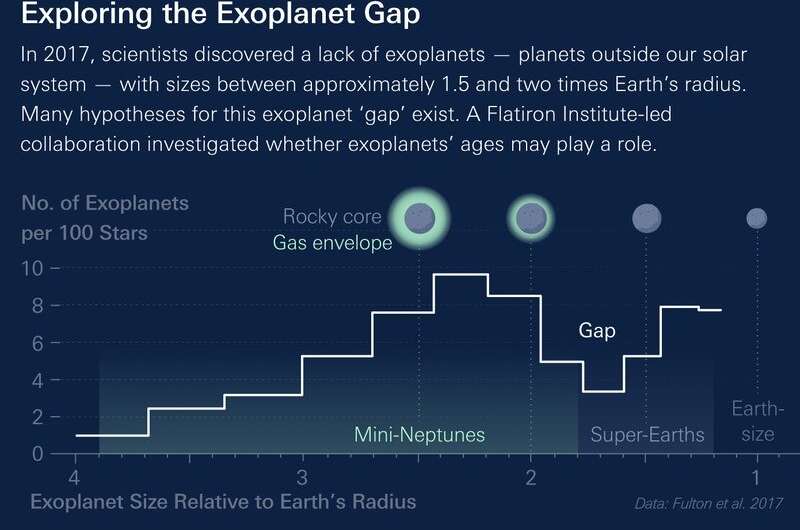
There's been a breakthrough in the case of the missing planets.
While planet-hunting missions have discovered thousands of worlds orbiting distant stars, there's a severe scarcity of exoplanets that measure between 1.5 and two times Earth's radius. That's the middle ground between rocky super-Earths and larger, gas-shrouded planets called mini-Neptunes. Since discovering this 'radius gap' in 2017, scientists have been sleuthing out why there are so few midsize heavenly bodies.
The new clue arose from a fresh way of looking at the data. A team of researchers led by the Flatiron Institute's Trevor David investigated whether the radius gap changes as planets age. They divvied up exoplanets into two groups—young and old—and reassessed the gap. The least common planet radii from the younger set were smaller on average than the least common ones from the older set, they found. While the scarcest size for younger planets was about 1.6 times Earth's radius, it's about 1.8 times Earth's radius at older ages.
The implication, the researchers propose, is that some mini-Neptunes shrink drastically over billions of years as their atmospheres leak away, leaving behind only a solid core. By losing their gas, the mini-Neptunes "jump" the planet radius gap and become super-Earths. As time goes on, the radius gap shifts as larger and larger mini-Neptunes make the jump, transforming into larger and larger super-Earths. The gap, in other words, is the chasm between the largest-size super-Earths and the smallest-size mini-Neptunes that can still retain their atmospheres. The researchers report their findings May 14 in The Astronomical Journal.
"The overarching point is that planets are not the static spheres of rocks and gas we sometimes tend to think of them as," says David, a research fellow at the Flatiron Institute's Center for Computational Astrophysics (CCA) in New York City. In some previously proposed models of atmosphere loss, "some of these planets were 10 times larger at the starts of their lives."
The findings lend credence to two previously proposed suspects in the case: leftover heat from planetary formation and intense radiation from the host stars. Both phenomena add energy into a planet's atmosphere, causing gas to escape into space. "Probably both effects are important," says David, "but we'll need more sophisticated models to tell how much each of them contributes and when" in the planet's life cycle.
The paper's co-authors include CCA research fellow Gabriella Contardo, CCA associate research scientist Ruth Angus, CCA associate research scientist Megan Bedell, CCA associate research scientist Daniel Foreman-Mackey and CCA guest researcher Samuel Grunblatt.
The new study used data collected by the Kepler spacecraft, which measured the light from distant stars. When an exoplanet moves between a star and Earth, the observed light from the star dims. By analyzing how quickly the planet orbits its star, the star's size, and the extent of the dimming, astronomers can estimate the exoplanet's size. These analyses ultimately led to the discovery of the radius gap.
Scientists have previously proposed a few potential mechanisms for the gap's creation, with each process taking place over a different timescale. Some believed that the gap occurs during planetary formation when some planets form without enough nearby gas to puff up their size. In this scenario, the planet's radius, and therefore the radius gap, would be imprinted at birth. Another hypothesis was that collisions with space rocks could blast away a planet's thick atmosphere, preventing tinier planets from accumulating lots of gas. This impact mechanism would take roughly 10 million to 100 million years.
Other potential mechanisms require more time. One proposal is that intense X-rays and ultraviolet radiation from a planet's host star strips gas away over time. This process, called photoevaporation, would take less than 100 million years for most planets but could take billions of years for some. Another suggestion is that remnant heat from a planet's formation slowly adds energy to the planet's atmosphere, causing gas to escape into space over billions of years.
David and his colleagues started their investigation by taking a closer look at the gap itself. Gauging the sizes of stars and exoplanets can be tricky, so they cleaned up the data to only include planets whose diameters were confidently known. This data processing revealed an emptier gap than previously thought.
The researchers then sorted the planets based on whether they were younger or older than 2 billion years. (Earth, for comparison, is 4.5 billion years old.) Since a star and its planets form simultaneously, they determined each planet's age based on its star's age.
The results suggest that smaller mini-Neptunes are unable to hold on to their gas. Over billions of years, the gas is stripped away, leaving behind a mostly solid super-Earth. That process takes longer for larger mini-Neptunes—which become the largest super-Earths—but won't impact the most gargantuan gas planets, whose gravity is strong enough to hold their atmospheres.
The fact that the radius gap evolves over billions of years suggests that the culprit isn't planetary collisions or an inherent quirk of planetary formation. Remnant heat from inside the planets gradually stripping away the atmosphere is a good fit, David says, but intense radiation from the parent stars could also contribute, especially early on. The next step is for scientists to better model how planets evolve to suss out which explanation plays a bigger role. That could mean considering additional complexities such as the interactions between fledgling atmospheres and planetary magnetic fields or magma oceans.
Explore further
Provided by Simons Foundation
Citation: Shrinking planets could explain mystery of universe's missing worlds (2021, May 17) retrieved 17 May 2021 from https://phys.org/news/2021-05-planets-mystery-universe-worlds.html
This document is subject to copyright. Apart from any fair dealing for the purpose of private study or research, no part may be reproduced without the written permission. The content is provided for information purposes only.
https://phys.org/news/2021-05-planets-mystery-universe-worlds.html
2021-05-17 15:17:38Z
CAIiEPAYAaHhHdYTj49V5FYoe5QqGAgEKg8IACoHCAowpbDpAzCm_hww3-XGBg
Bagikan Berita Ini















0 Response to "Shrinking planets could explain mystery of universe's missing worlds - Phys.org"
Post a Comment